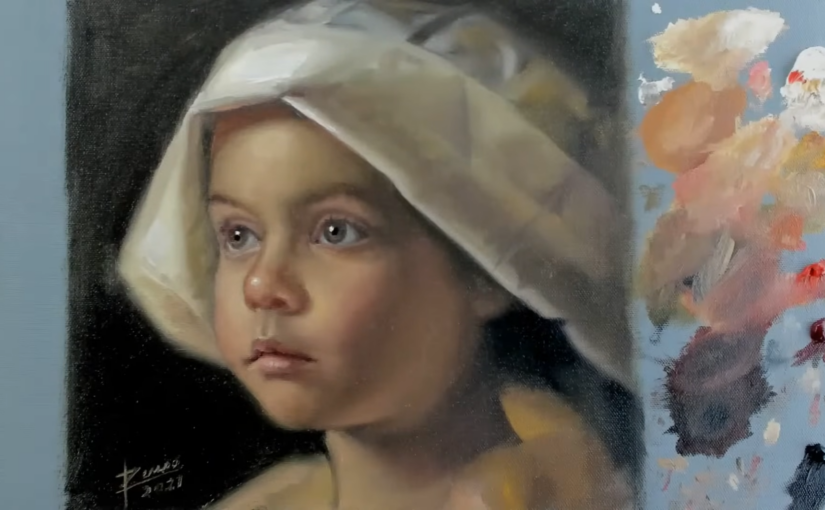Portrait painting is a journey of observation, technique, and storytelling. As an artist, I’ve spent years honing my craft, learning to capture the essence of a subject through brushstrokes and color. In this article, I’ll share insights from my process, practical tips for aspiring portrait painters, and a few personal stories that remind us why art is as much about the journey as it is about the final piece. Whether you’re an art student or a portrait enthusiast, I hope these lessons inspire you to pick up your brush and create.
Starting with the Basics: Simplifying Complex Forms
Every portrait begins with a blank canvas and a vision. For me, the key to tackling the complexity of the human face is to break it down into simple shapes. When I started the portrait of a baby featured in this session, I began by sketching the forehead as a triangle. This approach helps me establish proportions and placement before diving into details.
Babies, in particular, present unique challenges. Their facial proportions differ from adults—eyes are lower, and the head is larger relative to the face. To accurately capture these subtleties, I measured carefully, using my brush as a guide to ensure the center line was balanced. This attention to foundational details is crucial for creating a lifelike portrait.

The Classical Approach: Underpainting and Layering
One of my favorite techniques is underpainting with green. This classical method, often used by the Old Masters, creates a luminous base that adds depth to the final piece. As I layered the paint, I aimed for a museum-like quality—soft edges, rich tones, and a timeless feel.
For skin tones, I mixed burnt umber, cadmium red, and yellow, gradually building up the layers. The goal was to achieve a translucent effect, allowing the green undertones to subtly shine through. This technique requires patience and a keen eye for color harmony, but the results are worth it.

The Power of Squinting: Seeing Values and Shapes
Throughout the process, I found myself squinting—a habit I’ve developed to simplify what I see. Squinting helps me focus on values and shapes, stripping away unnecessary details. It’s a trick I highly recommend to students. By training your eye to see the big picture first, you can avoid getting lost in the minutiae.
For example, when painting the baby’s face, I squinted to identify the lightest highlights and darkest shadows. This allowed me to create a sense of volume and roundness, essential for bringing the portrait to life.

A Lesson from New York: Taking Risks and Embracing Challenges
A Story from New York: The Art Gallery and the False Name
As the painting began to take shape, I found myself reminiscing about my time in New York. It was 17 years ago, and I had just arrived in the city, wide-eyed and full of dreams. My English was shaky, but my passion for art was unwavering. One day, while on my way to the Metropolitan Museum, I stumbled upon two painters in the subway. They were speaking Spanish, and I felt an instant connection. We struck up a conversation, and they invited me to join them at an art gallery in Manhattan.
The gallery was unlike anything I had ever seen. It was more like a store, filled with paintings from floor to ceiling. The owner, a woman from China, handed me a canvas with a poster in the middle and instructed me to paint the borders. It was a strange request, but I didn’t question it. I painted diligently, blending the colors to match the image. By the end of the day, I had completed three paintings. The woman offered me a job on the spot, paying $8 an hour. I accepted, but there was one problem—I had given her a false name.
For two months, I worked at the gallery under my assumed name. Every Friday, the painters would gather at a local bar to unwind. It was there that I met some of the most incredible people I’ve ever known. They were from all over the world—Russia, China, Latin America—and we bonded over our shared love of art. One of them told me, “In this city, we have to help each other.” Those words stayed with me, a reminder of the kindness and camaraderie I found in New York.
But my time at the gallery wasn’t without its challenges. On my first payday, I realized I couldn’t cash my check because it was made out to the false name I had given. Panicked, I confided in one of my coworkers. He assured me it wouldn’t be a problem, and sure enough, the bank cashed the check without question. It was a small victory, but it taught me an important lesson: sometimes, you have to take risks to pursue your dreams.

The Importance of Softness: Blending and Transitions
Back in the studio, I focused on refining the portrait. The baby’s face was almost complete, but the shadows felt too harsh. I softened the edges, blending the colors to create a more natural, translucent effect. This step is crucial for achieving a lifelike appearance.
I also paid close attention to the lightest highlights, placing them on the tip of the nose and the cheeks. These subtle touches added warmth and dimension to the face. Remember, portrait painting is about balance—knowing when to add detail and when to step back.

Final Thoughts: Art as a Journey
As I signed the finished portrait, I reflected on the journey that brought me here. Painting is more than just a skill; it’s a way of seeing the world. It’s about finding beauty in the ordinary, turning mistakes into opportunities, and sharing stories through your work.
To all the art students and portrait enthusiasts reading this, I encourage you to embrace the process. Experiment with techniques, learn from your mistakes, and never stop creating. And most importantly, remember that every brushstroke is a step forward in your artistic journey.

